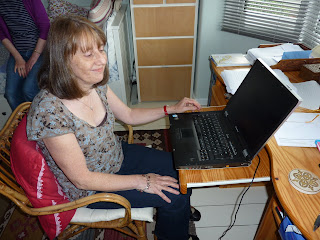

I am always fascinated to see the places where other writers live and work. When – twenty years ago, I can hardly believe it! - I first visited Greenaway, where Agatha Christie lived, I was greatly intrigued, and I mentioned a while back my pleasure at visiting Margaret Yorke in her delightful cottage, with a study crammed with books. And Eileen Dewhurst, now retired but a Wirral based writer of note, has a great set-up in her flat in Birkenhead.
Closer to home in Cheshire, Kate Ellis has for many years worked out in the garden in a specially designed garden room. But now she’s moved her study and workplace indoors. She is a gifted plotter, and it’s fascinating to see how she maps out her intricate mysteries in a very visual way. This is something I don’t do, but it’s a method that has a good deal to commend it, I think. And the success of Kate’s ingenious puzzles shows that it works very well in accomplished hands.
What Kate and I do have in common as writers is that we both know the solution to the main mystery from the outset. My own starting point is almost invariably an interesting motive for murder. And that is why I am not one of those crime writers who does not know where the story is going to wind up when they begin writing. But all methods are valid – they are simply a means to an end. What really matters is the quality of the end product.
6 comments:
Martin - Thanks very much for sharing a glimpse into Kate Ellis' world - and your own. You are absolutely right; there are many ways to get at the end product. If the mystery is a good one, there is no one right way to go about it.
I love hearing about the mechanics of your writing, Martin. How long do you spend in the planning before you set anything down on paper(or into the computer, I suppose it must be?) How long does it take for the complete first draft, how long re-writing, and do you start the next one before the current one is entirely out of your hands?
Oh, and proof reading: is it still as long winded as the old fashioned system wih galley proofs and whatnot? There was an interesting bit about this aspect in one of Dornford Yates' semi-autobiographical works but I'm sure things must be very different from when he was writing, roughly 1910-1960.
It's always interesting for those of us who are starting to write to see how others approach it. I can't imagine setting out to write a crime novel without knowing the ending one is working towards, but those who do it this way seem to be very successful. For example, Ann Cleeves spoke about 'finding out what happens, like the reader' at Hexham Book Festival earlier in the year.
I suppose it's a matter of finding what suits you best.
Fiona - yes, it is on the PC, but I am currently exploring voice recognition too.
Proof reading - very tedious as far as I'm concerned!
I will talk more about this on another day, as it is a topic with a lot of meat in it.
Janet, yes, Ann and I have over the years often debated our differences of plot building. It does intrigue me as a subject.
As Margot says, there is no one right way.
Hi Martin – I agree writers’ rooms are fascinating; I shall always remember a visit to Dylan Thomas’ boathouse in Laugharne some years ago. I like the pics of Kate in her study – amazing to think of the fiendish plots brewing up behind her lovely smile! Interesting to note from her October ’07 interview with Raychel Harvey-Jones on Legal TV that whilst she more or less knows from the beginning how her books will end, there’ve been a couple where she’s changed the murderer!
Are you managing to resist the charms of this glorious autumn Sunday to press on with ‘The Hanging Tree’? It would certainly be a memorable date upon which to complete the first draft, wouldn’t it, 10-10-10? Kate, in her Legal TV interview, said she regarded the first draft of a novel as like the stone for a sculpture – something to chip away at. She did about five drafts, start to finish. A perfectionist, clearly! How many do you usually do?
Perhaps you could pop a couple of pics of your own workroom on the blog, Martin. I imagine you having a view over Lymm Dam – but maybe that would be too distracting!
Regards, Paul
Post a Comment